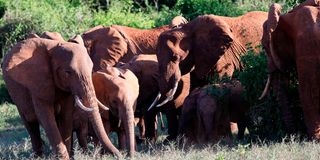Nature’s battle field: Taita Taveta’s unending battle with marauding elephants

Elephants feeding at the Taita Hills Wildlife Sanctuary within the Tsavo West National Park in Taita Taveta County in January. People living around the park are in constant fear.
In the remote villages surrounding the Tsavo National Park, a daily battle rages on. It is especially a big battle for school-going children, whose journey to and from their institutions is a daily risk.
Ms Phibiana Wambugha, a mother of four, begins her morning routine way before sunrise. She has to be up early to prepare her children for school. They are all enrolled at Ngogodinyi Primary School that is nestled within Wundanyi constituency in Taita Taveta County.
At the crack of dawn, Phibiana together with her children begin their four-kilometre journey to school. She knows all too well what lies in the thickets: they might cross paths with elephants.
With a watchful eye, she walks behind them, her presence a constant source of comfort and reassurance. She escorts them for almost two kilometres.
“By a quarter to six, we leave home. I am usually in the company of another neighbour. We escort the children up to a certain point then return,” Ms Wambugha tells us as she wraps a shawl around her shoulders. “The only shortcut to get to school faster is through the forest.”
Like many households in Kishushe in Wundanyi, the proximity to a national park poses a unique challenge. Every day becomes a calculated risk.
Delicate dance
“Sometimes while on the road, they (children) meet the jumbos and are forced to run away. Like the previous day when they came from school, the youngest was crying because they had encountered some animals. When they are not at peace, I am not at peace,” Ms Wambuga asserts.
About 70 kilometres away from Kishushe is Kajire village, which lies at the foot of the Sagalla Hills in Taita Taveta.
There, residents also grapple with the delicate dance between themselves and elephants.
We visit Kajire Primary School, where learners face a similar challenge. And it is worse for them because there is hardly enough to eat at home because jumbos often raid their parents’ farms and damage crops.
“Some of the learners come to school on empty stomachs. So, even learning becomes a challenge,” she said. “Sometimes we even look for well-wishers to provide at least flour for porridge.”
Many of the learners depend on the free meals provided at the school to keep their little tummies filled and to stay in school.
The deputy head teacher says they are forced to release the learners early, especially those in the lower classes, so that they can reach home before elephants begin roaming.
Mr Josephat Mwanzo, the chair of the Primary School board, tells us this is a perennial problem.
“Because the learners are day scholars, they are having constant brushes with the animals, especially in the evenings and in the mornings. So, pupils can’t arrive on time. It is a persisting problem in Kajire,” he notes.
Kajire is a village that never sleeps. On most nights, residents here spend time in their farms while on the lookout for the elephants. They make loud noises, use torches and light up small bonfires mixed with pepper and even elephant dung. However, these measures have proven ineffective against the sheer size and determination of the elephants.
The Tsavo conservation area spans across 42,000 square kilometres. It is home to Kenya’s largest elephant population. It comprises the Tsavo East and West National parks, the Chyulu Hills National Park and the South Kitui National Reserve, making up nearly half of Kenya’s protected land.
There were 36,280 elephants in the country in 2021 when KWS conducted a census. Around 16,000 elephants live in the Tsavo conservation area, according to the Africa Wildlife Foundation.
Dr Yussuf Wato, a biodiversity research and innovation manager with the World Wide Fund for Nature in Kenya, says the situation is connected to climate change.
“In the 1970s, Tsavo had about 40,000 elephants,” says Dr Wato. “Now, the population (is) 14,000 but the incidents of human-wildlife conflict are actually more now than when the population was 40,000. This is because the human population is increasing.”
“It is also because of the growing economy,” he adds. “Because of all this, the migratory corridors that used to be open are now blocked. Another impact of drought is that a lot of water sources that used to exist have now dried up.”
Tsavo has two permanent rivers — the Voi River and the Galana River. There is also the seasonal Tiva River.
Water-dependent animals
“Species like elephants are water-dependent animals. If they don’t get sufficient water in the park, they’ll go out and human-wildlife conflict will occur,” says Dr Wato.
Elephants have roamed these lands for centuries. However, the growing human population means their ancient migratory routes are steadily being reshaped.
“Elephants historically know their routes and they understand seasons and the places they can get water,” says Amos Chege, a species conservation officer at the Africa Wildlife Foundation.
“We have fewer cases of human-wildlife conflict in the rainy season than in the dry seasons. The rainy season is coming to an end, so we will experience an increase in conflict in the next few months,” he adds.
Conservationists suggest coexisting mechanisms like the provision of water pans of wildlife within the parks and provision of water for livestock outside parks.
In the financial year 2023-2024, the national government has allocated Sh319 million for the drilling of boreholes to provide water for wildlife within protected lands.
Another issue is the ecological degradation within the parks. A number of invasive species that are not good forage for wildlife has forced the animals to go searching for better forage outside the protected areas.
Conservationists hold that the government should relook at the land use system in protected areas like in Tsavo to address these challenges.
“No legal framework limits these communities for whatever land uses. In most cases, you’ll find that they engage in livelihoods that are incompatible to conservation, like agriculture. When that happens, these animals will migrate and cause conflict,” Dr Wato says.
“One of the ways in which we can tackle this is to ensure communities benefit from conservation and they see conservation as a competitive land use where they can benefit from,” he adds.
The KWS did not respond to our request for a comment on the situation around the Tsavo conservation area .
As the world confronts climate change-related problems, the conservation of elephants and their habitats remain intertwined with the survival of communities like the ones neighbouring Tsavo.
For now, however, pupils who strive to get to school despite the hurdles they encounter every single day, hold the key to a future where coexistence between man and the jumbos is a reality.




